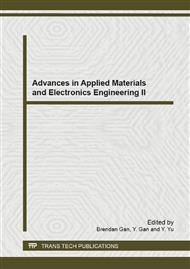[1]
E Gilbert, D Johnson. Distance functions and their application to robot path planning in the presence of obstacles. IEEE Journal of Robotics and Automation, 1985, Issue 1 of Vol 1: 21 – 30.
DOI: 10.1109/jra.1985.1087003
Google Scholar
[2]
A. Zelinsky R.A. Jarvis,J. Byrne,S. Yuta. Planning paths of complete coverage of an unstructured environment by a mobile robot. International Conference on Advanced Robotics, Tokyo, Japan, 1993: 533–538.
Google Scholar
[3]
H Choset. Coverage for robotics – A survey of recent results. Annals of Mathematics and Artificial Intelligence, Numbers 1-4, Vol 31, 2001: 113-126.
Google Scholar
[4]
T Oksanen. Coverage path planning algorithms for agricultural field machines. A Visa la - Journal of Field Robotics; Issue 8, Vol26, Aug 2009: 651–668.
DOI: 10.1002/rob.20300
Google Scholar
[5]
R.A. Brooks. A robust layered control system for a mobile robot. IEEE J. Robotics Autom, (1986).
Google Scholar
[6]
Ismail AL-Taharwa, Alaa Sheta and Mohammed Al-Weshah. A mobile robot path planning using genetic algorithm in static environment. Journal of Computer Science 4 . 2008: 341-344.
DOI: 10.3844/jcssp.2008.341.344
Google Scholar
[7]
Ersson,T., and Hu. Path planning and navigation of mobile robots in unknown environments. IEEE International Conferenceon on Intelligent Robots and Systems(IROS). (2001).
DOI: 10.1109/iros.2001.976276
Google Scholar
[8]
Q Wu, Y Yu. Feature matching and deformation for texture synthesis. ACM Transactions on Graphics (TOG) - Proceedings of ACM SIGGRAPH, Issue 3, Vol 23, Aug 2004: 364-367.
DOI: 10.1145/1015706.1015730
Google Scholar
[9]
C Schutz, T Jost, H Hugli. Multi-feature matching algorithm for free-form 3D surface registration. Fourteenth International Conference on Pattern Recognition, Aug 1998,vol. 2 : 982 – 984.
DOI: 10.1109/icpr.1998.711852
Google Scholar
[10]
Y Chen, JZ Wang. A region-based fuzzy feature matching approach to content-based image retrieval. IEEE Transactions on Pattern Analysis and Machine Intelligence, Sep 2002, Issue 9 , Vol 24: 1252 – 1267.
DOI: 10.1109/tpami.2002.1033216
Google Scholar
[11]
Y Chen, JZ Wang. Looking beyond region boundaries: A robust image similarity measure using fuzzified region features. The 12th IEEE International Conference on Fuzzy Systems, May 2003, vol. 2 : 1165 – 1170.
DOI: 10.1109/fuzz.2003.1206596
Google Scholar
[12]
M Wang, JNK Liu. Fuzzy logic based robot path planning in unknown environment. International Conference on Machine Learning and Cybernetics, Aug. 2005, vol. 2: 813-818.
DOI: 10.1109/icmlc.2005.1527055
Google Scholar
[13]
G Antonelli, S Chiaverini. A Fuzzy-Logic-Based Approach for Mobile Robot Path Tracking. Fuzzy Systems, IEEE Transactions on April . 2007, Issue 2 , Vol 15 : 211 – 221.
DOI: 10.1109/tfuzz.2006.879998
Google Scholar


